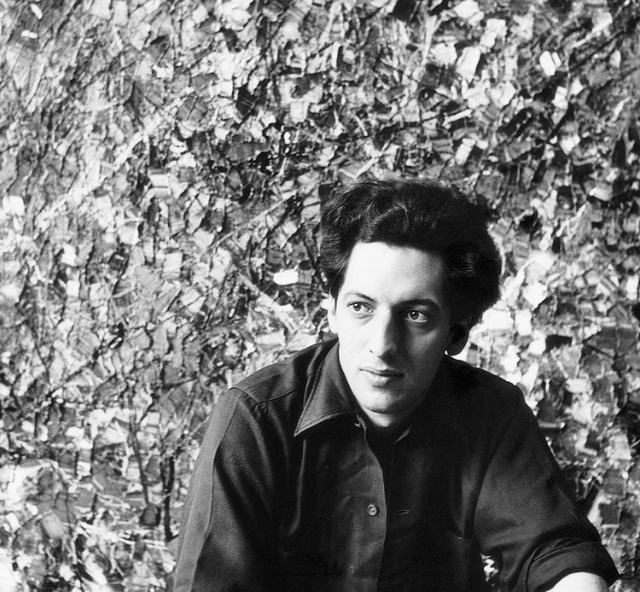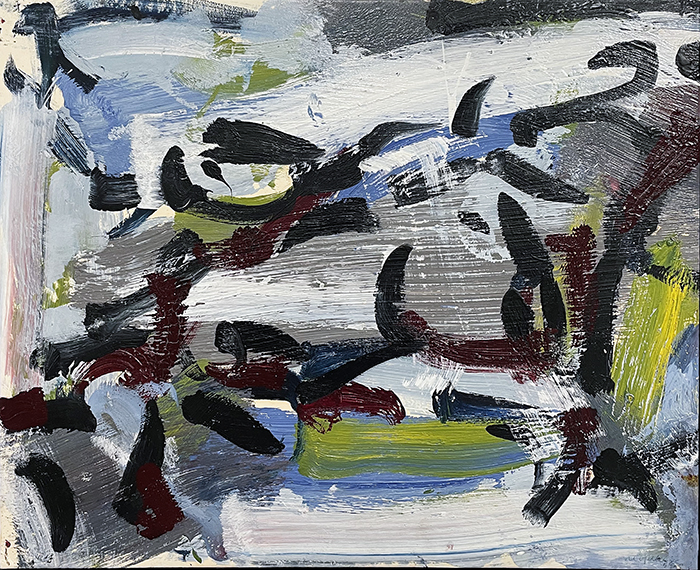Jean-Paul Riopelle
Jean-Paul Riopelle (1923-2002) - Biography
Jean Paul Riopelle began his career at the école polytechnique in 1941, pursuing engineering with some architecture and photography. His childhood enthusiasm for making art became a hobby at this time, and he described himself as a Sunday painter with a constrained, academic style. In 1942 he enrolled at the école des Beaux-Arts in Montreal but shifted his studies to the much less academic approach at the école du Meuble, graduating in 1945. There he studied with Paul-émile Borduas, a teacher who was extremely dedicated to his students and gave them a great deal of freedom. It was under Borduas's direction that Riopelle made his first abstract painting. Borduas and several of his students, including Riopelle, formed a group that worked, socialized and exhibited together (1942-45). The group became known as the Automatistes for their spontaneous method of painting, which drew on the subconscious as a source. In 1946 Riopelle first travelled to France, where he would return and settle the following year. In 1948 Borduas authored the manifesto Refus global, which was signed by a number of his students, including Riopelle.
Riopelle had his first solo exhibition at the Surrealist meeting place, Galerie La Dragonne in Paris, in 1949. During the late 1940s and early 1950s, he met and became friends with artists, writers and gallery owners including Georges Mathieu and Pierre Loeb, who introduced him to André Breton. He also met Jean Arp and Antonin Artaud at Loeb's gallery.
Riopelle pioneered a style of painting where large quantities of varied coloured paints were thickly applied to the canvas with a trowel for such works as Pavane (1954) and The Wheel II (1956). The coming years brought Riopelle increasing success and immersion in the Parisian cultural scene. He was represented in New York and participated in the biennials of contemporary art in Venice (1954) and Sao Paulo (1955). He spent his evenings in Paris bistros with friends including playwright Samuel Beckett and artist Alberto Giacometti.
In the 1960s, Riopelle renewed his ties to Canada. Exhibitions were held at the National Gallery of Canada (1963), and the Musée du Quebec held a retrospective in 1967. In the early 1970s, he built a home and studio in the Laurentians. From 1974 he divided his time between St. Marguerite in Quebec, and Saint-Cyr-en-Arthies in France. Riopelle participated in his last exhibition in 1996. From 1994 until his death, he maintained homes in both St. Marguerite and Isle-aux-Grues, Quebec.
Bio c/o National Gallery of Canada
Major Exhibitions:
1946: Painting Exhibition (Exposition de peinture), 1257 Amherst Street, Montreal.
1947: Summer, Surrealism (Surréalisme en 1947), 6th International Exhibition of Surrealism, Galerie Maeght, Paris. André Breton and Marcel Duchamp, curators.
1951: Confronted Vehemences (Véhémences confrontées), Galerie Nina Dausset, Paris. Michel Tapié, curator.
1953-4: Younger European Painters: A Selection, Guggenheim Museum, New York. Travelling exhibition: Minneapolis, Portland, San Francisco, Dallas, Fayetteville.
1967: Summer, Riopelle 67, Musée du Québec, Quebec City. Guy Viau, curator.
1972: Strings and Other Games (Ficelles et autres jeux), Canadian Cultural Centre, Paris, and Musée d’art moderne de la Ville de Paris.
1981-82: Jean Paul Riopelle. Painting 1946–1977 (Jean Paul Riopelle. Peinture 1946-1977), National Museum of Modern Art, Centre Georges Pompidou, Paris; and Musée du Québec, Quebec City. Travelling exhibition: Mexico, Caracas, and Montreal. Catalogue.
1996: Tribute to Rosa Luxemburg (Hommage à Rosa Luxemburg), Musée du Québec, Quebec City. Catalogue.
2002: Riopelle, Montreal Museum of Fine Arts. Catalogue.
2018-19: Mitchell/Riopelle, Nothing in Moderation (Mitchell/Riopelle, un couple dans la démesure), Musée national des beaux-arts du Québec, Quebec City. Travelling exhibition: Toronto and Landerneau. Michel Martin, curator. Catalogue.
2020: The Call of Northern Landscapes and Indigenous Cultures (Riopelle: à la rencontre des territoires nordiques et des cultures autochtones), Montreal Museum of Fine Arts. Catalogue.
Selected Permanent Collections:
Fondation Gandur Pour L’Art, Geneva, Switzerland
Hirshhorn Museum and Sculpture Garden, Washington DC
Montreal Museum of Fine Arts, QC
Musée d’art contemporain de Montreal, QC
Musée d’art de Joliette, QC
Musée national des beaux-arts du Québec, QC
Museum Ludwig, Cologne, Germany
National Gallery of Canada, Ottawa ON
Solomon R. Guggenheim Museum, New York, NY
Art Gallery of Ontario, ON
Museum of Modern Art, New York, NY
Artist Specialization: Riopelle's style in the 1940s changed quickly from Surrealism to Lyrical Abstraction (related to abstract expressionism), in which he used myriad tumultuous cubes and triangles of multicolored elements, facetted with a palette knife, spatula, or trowel, on often large canvases to create an overall sense of movement. The presence of long filaments of paint in his painting from 1948 through the early 1950s has often been seen as resulting from a dripping technique like that of Jackson Pollock. Rather, the creation of such effects came from the act of throwing, with a palette knife or brush or directly from the paint tube, large quantities of paint onto the stretched canvas (positioned vertically). Riopelle's voluminous impasto became just as important as color. His oil painting technique allowed him to paint thick layers, producing peaks and troughs as copious amounts of paint were applied to the surface of the canvas. Riopelle, though, claimed that the heavy impasto was unintentional: "When I begin a painting," he said, "I always hope to complete it in a few strokes, starting with the first colours I daub down anywhere and anyhow. But it never works, so I add more, without realizing it. I have never wanted to paint thickly, paint tubes are much too expensive. But one way or another, the painting has to be done. When I learn how to paint better, I will paint less thickly." This aspect of the "unintentional" is in keeping with Riopelle's interest in Surrealism and using "absolute chance" to create art. A third element, range of gloss, in addition to color and volume, plays a crucial role in Riopelle's oil paintings. Paints are juxtaposed so that light is reflected off the surface not just in different directions but with varying intensity, depending on the naturally occurring gloss finish (he did not varnish his paintings). These three elements; color, volume, and range of gloss, would form the basis of his oil painting technique throughout his long and prolific career.


